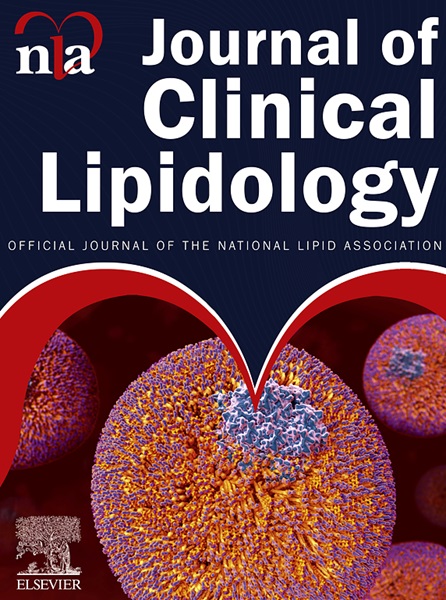Role of apolipoprotein B in the clinical management of cardiovascular risk in adults: An Expert Clinical Consensus from the National Lipid Association
IF 3.6
3区 医学
Q2 PHARMACOLOGY & PHARMACY
引用次数: 0
Abstract
This National Lipid Association (NLA) Expert Clinical Consensus provides an overview of the physiologic and clinical considerations regarding the role of apolipoprotein B (apoB) measurement to guide clinical care based on the available scientific evidence and expert opinion. ApoB represents the total concentration of atherogenic lipoprotein particles in the circulation and more accurately reflects the atherogenic burden of lipoproteins when compared to low-density lipoprotein cholesterol (LDL-C). ApoB is a validated clinical measurement that augments the information found in a standard lipoprotein lipid panel; therefore, there is clinical value in using apoB in conjunction with a standard lipoprotein lipid profile when assessing risk and managing lipid-lowering therapy (LLT). ApoB has been shown to be superior to LDL-C in risk assessment both before and during treatment with LLT. In individuals, there can be discordance between levels of LDL-C and apoB, as well as LDL-C and non-high-density lipoprotein cholesterol (non-HDL-C), despite high levels of population-wide correlation. When there is discordance between LDL-C and apoB, or LDL-C and non-HDL-C, atherosclerotic cardiovascular disease risk generally aligns better with apoB or non-HDL-C. Additionally, apoB can be used in tandem with standard lipoprotein lipid measurements to diagnose distinct lipoprotein phenotypes. ApoB testing can inform clinical prognosis and care, as well as enable family cascade screening, when an inherited lipoprotein syndrome is identified. The NLA and other organizations will continue to educate clinicians about the role of apoB measurement in improving clinical risk assessment and dyslipidemia management. An urgent need exists to improve access and reimbursement for apoB testing.
脂蛋白 B 在成人心血管风险临床管理中的作用:全国血脂协会专家临床共识。
美国国家血脂协会 (NLA) 专家临床共识概述了有关载脂蛋白 B(apoB)测量作用的生理学和临床考虑因素,以现有科学证据和专家意见为基础指导临床治疗。载脂蛋白 B 代表血液循环中致动脉粥样硬化脂蛋白颗粒的总浓度,与低密度脂蛋白胆固醇 (LDL-C) 相比,它能更准确地反映脂蛋白的致动脉粥样硬化负担。载脂蛋白B是一种经过验证的临床测量方法,可增强标准脂蛋白血脂组合中的信息;因此,在评估风险和管理降脂治疗(LLT)时,将载脂蛋白B与标准脂蛋白血脂组合结合使用具有临床价值。在使用 LLT 治疗前和治疗期间,载脂蛋白在风险评估中的作用均优于 LDL-C。在个体中,低密度脂蛋白胆固醇和载脂蛋白B以及低密度脂蛋白胆固醇和非高密度脂蛋白胆固醇(non-HDL-C)的水平可能不一致,尽管整个人群的相关性很高。当低密度脂蛋白胆固醇与载脂蛋白B或低密度脂蛋白胆固醇与非高密度脂蛋白胆固醇之间存在不一致时,动脉粥样硬化性心血管疾病风险通常与载脂蛋白B或非高密度脂蛋白胆固醇更为一致。此外,载脂蛋白B可与标准脂蛋白血脂测量同时使用,以诊断不同的脂蛋白表型。当发现遗传性脂蛋白综合征时,载脂蛋白B检测可为临床预后和护理提供依据,并可进行家族串联筛查。NLA 和其他组织将继续向临床医生宣传载脂蛋白 B 检测在改善临床风险评估和血脂异常管理中的作用。目前迫切需要改善载脂蛋白 B 检测的可及性和报销情况。
本文章由计算机程序翻译,如有差异,请以英文原文为准。
求助全文
约1分钟内获得全文
求助全文
来源期刊
CiteScore
7.00
自引率
6.80%
发文量
209
审稿时长
49 days
期刊介绍:
Because the scope of clinical lipidology is broad, the topics addressed by the Journal are equally diverse. Typical articles explore lipidology as it is practiced in the treatment setting, recent developments in pharmacological research, reports of treatment and trials, case studies, the impact of lifestyle modification, and similar academic material of interest to the practitioner.
Sections of Journal of clinical lipidology will address pioneering studies and the clinicians who conduct them, case studies, ethical standards and conduct, professional guidance such as ATP and NCEP, editorial commentary, letters from readers, National Lipid Association (NLA) news and upcoming event information, as well as abstracts from the NLA annual scientific sessions and the scientific forums held by its chapters, when appropriate.

 求助内容:
求助内容: 应助结果提醒方式:
应助结果提醒方式:


